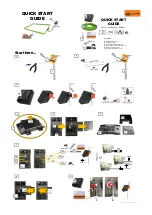
LANDI RENZO S.p.A.
‘SE 81 SIC’ LPG REGULATORS INSTALLATION AND ADJUSTMENT MANUAL
8 / 19
Notices
3. GENERAL NOTICES
To install the regulator, the following instructions
must be observed:
• install the regulator in the engine compartment
as close as possible to the point where the mixer
is to be installed, securing it integrally with the
bodywork using the screws provided;
• position the regulator away from air intake
components for the ventilation and heating of the
passenger compartment;
• position the regulator at a distance not inferior to
150 mm from the exhaust pipes or silencer. In
case the distance is inferior to the minimum value,
but not greater than 75 mm, it is necessary to
insert between the elements a metal sheet (or
equivalent material) with a minimum thickness of
1 mm.
• position the regulator in parallel with the direction
of travel and in an upright position so that it is
easily accessible to allow adjustment and
maintenance work;
• check that the regulator is placed in a lower
position than the highest point of the radiator in
order to prevent air bubbles forming in the water
circuit;
• take care not to position the regulator so that the
bleed plug is above the distributor or above the
ignition coil;
• carefully clean the tank and the LPG supply
pipes before they are finally connected to the
regulator to prevent any impurities getting inside
the regulator;
• check that with the engine running there is no
leakage from the water pipes (generally connected
to the passenger compartment heating circuit);
• check that the regulator heats up quickly by
means of the engine cooling circuit connection.
Every time the engine cooling circuit is emptied it
is necessary to restore the level of liquid, taking
care any air bubbles are eliminated as they could
prevent the regulator from heating.
The regulator gas outlet should be connected to
the mixer preventing the connecting pipe (which
must be as short as possible) from having any
bends or pockets.
The regulator is supplied with securing brackets to
position the regulator in the engine compartment.
These brackets will need to be adapted in relation
to the point of the engine compartment chosen for
securing.
Regulators setting
4. SETTING PROCEDURE FOR REGULATORS
TYPE ‘SE 81 SIC’
with exhaust gas analyser
(Fig. 1)
4.1 CATALYSED CAR
The first step is to adjust peak speed:
• take the engine at about 3,500 r.p.m. until
reading on the Tester Programmer Mod. V05 that
the default value is recorded.
The second step is to adjust idling speed:
• with the engine running, turn the idle speed
setting screw (E) (clockwise it decreases,
anticlockwise it increases) until, on the Tester
Programmer Mod. V05, the number of steps of the
linear electromechanical actuator indicated in
menu ‘Display’ at the word MOT is equal (or as
close as possible) to the value indicated at the
word DEF.
• always check that the lambda scale LED’s
indicating carburation are flashing properly.
• Check by the gas analyser that the Lambda
value is about 1.000, CO and HC values are the
lowest possible (tending to zero) and CO
2
value is
about 13-14% or the highest possible
.
For deeply details see ‘Instruction manual for
installation and adjustment Lambda Control
System A1 V05’ and ‘Tester Programmer Mod.
V05 instruction manual’ for the procedure of
recording the carburation.
Having regulated idling and peak speeds, carry
out a test on the road.
4.2 INJECTION CAR
The first step is to adjust peak speed:
• take the engine at about 3,500 r.p.m. and turn
the peak speed regulator located on the start
petrol solenoid valve, between the regulator and
the mixer, to take the values of CO, HC and CO
2
as shown in the table.
The second step is to adjust idling speed:
• with the engine running, turn the Idle speed
setting screw (E) (clockwise it decreases,
anticlockwise it increases) to take the values of
CO, HC and CO
2
as shown in the table.
Having regulated idling and peak speeds, carry
out a test on the road.




































